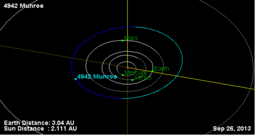4942 Munroe
4942 Munroe, provisional designation 1987 DU6, is an asteroid from the inner regions of the asteroid belt, approximately 3 kilometers in diameter. It was discovered on 24 February 1987, by Belgian astronomer Henri Debehogne at ESO's La Silla Observatory in northern Chile, and later named after American cartoonist and former NASA roboticist Randall Munroe.[2]
 Orbital diagram of Munroe | |
| Discovery [1] | |
|---|---|
| Discovered by | H. Debehogne |
| Discovery site | La Silla Obs. |
| Discovery date | 24 February 1987 |
| Designations | |
| (4942) Munroe | |
Named after | Randall Munroe (American cartoonist)[2] |
| 1987 DU6 · 1955 MS 1971 GE · 1990 CB | |
| main-belt · (inner) | |
| Orbital characteristics [1] | |
| Epoch 4 September 2017 (JD 2458000.5) | |
| Uncertainty parameter 0 | |
| Observation arc | 61.76 yr (22,559 days) |
| Aphelion | 2.5000 AU |
| Perihelion | 1.9026 AU |
| 2.2013 AU | |
| Eccentricity | 0.1357 |
| 3.27 yr (1,193 days) | |
| 9.2509° | |
| 0° 18m 6.48s / day | |
| Inclination | 3.8333° |
| 278.09° | |
| 11.227° | |
| Physical characteristics | |
Mean diameter | 3.453±0.139 km[3] |
| 0.936±0.183[3] | |
| SMASS = X [1] | |
| 13.5[1] | |
Orbit and classification
Munroe orbits the Sun in the inner main-belt at a distance of 1.9–2.5 AU once every 3 years and 3 months (1,193 days). Its orbit has an eccentricity of 0.14 and an inclination of 4° with respect to the ecliptic.[1] It was first identified as 1955 MS at the Leiden Southern Station (Johannesburg-Hartbeespoort) in 1955, extending the body's observation arc by 32 years prior to its official discovery observation.[2]
Physical characteristics
In the SMASS taxonomy, Munroe is characterized as an X-type asteroid. It has an absolute magnitude of 13.5.[1]
Diameter and albedo
According to the survey carried out by the NEOWISE mission of NASA's Wide-field Infrared Survey Explorer, Munroe measures 3.453 kilometers in diameter and its surface has an exceptionally high albedo of 0.936.[3] On his private blog, Randall Munroe (after whom the asteroid is named) calculates that the asteroid is between 6 and 10 kilometers in diameter, comparable in size to the Chicxulub asteroid.[4]
Lightcurves
As of 2017, Munroe's rotation period, poles and shape remain unknown.[1][5]
Naming
In 2013, it was named after Randall Munroe (born 1984), a former NASA roboticist and the author of the webcomic xkcd.[6] The name was chosen by xkcd readers Lewis Hulbert and Jordan Zhu.[7] The official naming citation was published on 22 July 2013 (M.P.C. 84378).[8]
References
- "JPL Small-Body Database Browser: 4942 Munroe (1987 DU6)" (2017-03-28 last obs.). Jet Propulsion Laboratory. Retrieved 4 July 2017.
- "4942 Munroe (1987 DU6)". Minor Planet Center. Retrieved 18 April 2017.
- Masiero, Joseph R.; Mainzer, A. K.; Grav, T.; Bauer, J. M.; Cutri, R. M.; Dailey, J.; et al. (November 2011). "Main Belt Asteroids with WISE/NEOWISE. I. Preliminary Albedos and Diameters". The Astrophysical Journal. 741 (2): 20. arXiv:1109.4096. Bibcode:2011ApJ...741...68M. doi:10.1088/0004-637X/741/2/68. Retrieved 18 April 2017.
- Munroe, Randall (30 September 2013). "Asteroid 4942 Munroe". xkcd. Retrieved 7 July 2014.
- "LCDB Data for (4942) Munroe". Asteroid Lightcurve Database (LCDB). Retrieved 18 April 2017.
- Richardson, Chris (2 October 2013). "xkcd Author Gets Asteroid Named After Him". iEntry Network. Archived from the original on 4 February 2015. Retrieved 8 May 2014.
- Lecher, Colin (October 2, 2013). "Aw, They Named An Asteroid After The Creator Of XKCD". nextmedia Pty Ltd. Archived from the original on May 12, 2014. Retrieved May 8, 2014.
- "MPC/MPO/MPS Archive". Minor Planet Center. Retrieved 18 April 2017.
External links
- Asteroid Lightcurve Database (LCDB), query form (info)
- Dictionary of Minor Planet Names, Google books
- Asteroids and comets rotation curves, CdR – Observatoire de Genève, Raoul Behrend
- Discovery Circumstances: Numbered Minor Planets (1)-(5000) – Minor Planet Center
- 4942 Munroe at AstDyS-2, Asteroids—Dynamic Site
- 4942 Munroe at the JPL Small-Body Database
